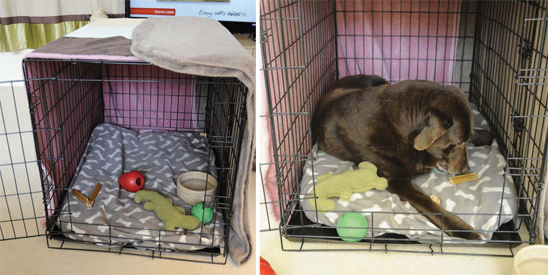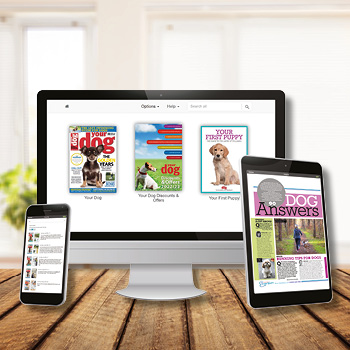You may think your dog is unaffected by your hectic home life, but the chances are he needs a retreat. Trainer Tony Cruse advises.
With today's busy lifestyles, home can be a chaotic place - people coming and going, shouting, children playing - it's often far from tranquil.
How does your dog deal with this? Not always very well is the answer. But you can help by creating a safe haven for him, a place for your dog to escape to if someone or something worries him. It can be his bed where he sleeps at night, or a newly created space.
A safe haven provides your dog with a choice and the option of escaping from a situation. He may not always choose to leave, but knowing there is such a place can build confidence in a dog. This article is about providing your dog with that choice.
An anxious animal is frequently a reactive animal. The opportunities are limited; it's often fight or flee. We want every dog to be given the choice to flee during any stressful situation. If a dog feels trapped, there is a distinct possibility he will warn the person with a growl, and if ignored, a bite. This is an obvious danger to people and to the dog.
If you consider the damage long-term stress can cause to an animal, it makes sense to provide your dog with a place to which he can escape when he finds that things are getting just too much.
The cause of anxiety attacks in dogs
Regular things that can cause anxiety for your dog include:
- Loud noises (fireworks/ vacuum cleaner/building work/outside traffic).
- Change of routine (owners leaving/arriving at different times).
- Unfamiliar visitors (repair men/new friends).
- Other pets (cats or dogs).
- Children playing (lots of movement and excitement).
- Domestic arguments.
The stress hormone
Any animal (including the two-legged kind) who is denied quality rest will have higher levels of cortisol (the stress hormone) in their body.
Cortisol is useful in small doses but a constant amount suppresses the immune system. Therefore, high levels over a long period can lead to health issues for your dog. It's yet another reason to provide your dog with a safe haven.
Signs of stress in dogs
You may think your dog or puppy is confident and happy. However, as humans, we often miss the very subtle signals which an uncomfortable and anxious dog displays. There are countless photos on social media sites of children grabbing and pushing up close to dogs. While some people see this as cute, I often hear alarm bells ringing when I recognise anxious canine body language. Shouldn't we all be aware of these important signals?
It helps to consider each one of these signs in the context of the situation. A yawning dog may just be a tired dog; a panting dog could be an active dog, but if the gasman is reading the meter and your dog is panting, your pet may be feeling worried. Seeing more than one of these signals together means there is a high chance that your dog is stressed.
- The stress yawn - often more intense than a relaxed, sleepy yawn.
- Panting - open-mouthed breathing in normal temperatures.
- Ears back - so they look flat against the head.
- Low tail - hanging lower than usual or clamped between the legs.
- Avoidance - glancing away and turning the head or whole body from you, or a particular person or situation.
- Growling - is a vocal indication the dog feels threatened and needs space. It has a very different meaning from enthusiastic growling during play.
- A stiff body - a relaxed dog has loose and ‘bendy' body language; for example, you'll often notice his back end wagging with his tail. A stiff, tall posture is a clear sign that the dog is alert and stressed.
Give your dog the choice to go to his safe place
A terrier runs around the living room, barking aimlessly because the dustbin men are pulling up outside the house. Wouldn't it be better if the dog made his way to his safe haven where he could remain quiet and relaxed? Dog training and behaviour is thankfully moving more towards addressing the reasons behind unwanted behaviour, in this case the barking.
Through my experience, I have often found that giving a dog every opportunity to make the correct decision, is better than commanding a dog. The dog is then thinking for himself and is rewarded for his good choice. To make this effective, the home environment needs to be set up so that he finds it difficult to make the wrong choice but making the right choice is easy and the best thing ever! A thinking dog is a confident dog and not a reactive dog.
Give your dog somewhere to run to
When things get on top of you, you can go to another room, shut the door and rest. It's good for the soul and perhaps for the others around you. But what about your dog? There are times when he may not want to be the object of the children's games, be chased by the other family dog, or be near a noisy vacuum cleaner. And if he is quietly resting in the living room and a child disturbs him or someone accidentally treads on his tail, he will start to get anxious. Where does he go? The answer is to give him somewhere to run to.
Creating a safe haven for your dog
Provide a blanket, bed, or snug crate in a place away from well-walked areas. Your dog may have already chosen a place he takes himself to, such as under a table or by the side of the settee. If this is the case you can simply put the blanket, bed, or open crate there. This now becomes your dog's safe haven.
For multi-dog households, each dog would need his own safe haven. Although a blanket or a dog bed placed in a secure area can be a safe haven, a crate will provide the all-around safety a dog may require. Some people perceive dog crates as a cage or prison, but it's perfectly possible to turn them into cosy and safe doggy dens. A safe haven is a resting area only, not a place to regularly feed your dog or to contain him. Choose a crate size that is not too big, about the size of the folded blanket or bed he currently sleeps on.
Leave your dog alone
Educate the household that when your dog is in his safe haven, he is left completely alone and he is paid no attention. You can tell the children that when he is in this location ‘pretend he is invisible and you can't see him'.
When he wants attention, there is no doubt he will get up and find it! Again, it's about choice. If you need him to go out in the garden, call him and excitedly walk off. Always allow him to come to you.
Dogs need a place to escape
Even if you think your dog is bomb proof and not in the least bit nervous, there will be times when he will need a place to escape, a sanctuary. Create a safe haven and make everyone aware of it.
A safe haven also provides feedback! If your dog takes himself off to his safe location, you can work out what may have been making him unhappy and so prevent it happening next time. For example, if you get the ironing board out and you notice your dog quickly moving towards his safe haven, it is likely he is nervous of that object. So next time you could help him out and avoid that situation, by giving him a tasty stuffed Kong in his bed before you start to do the ironing, helping reduce his stress levels.
Giving your dog that choice to move away and into his safe haven will build his confidence, keep his mind and body healthy, and help maintain a calm family home.
Is your dog anxious?
To establish this quickly, take a step back. Pause and observe. What does your dog do? Does he approach the situation/person or does he avoid it?

Setting up a crate for your dog
Your dog should be out of sight when you perform steps 1 – 6 below. This will prevent him from being spooked by the set up process.
1. Crates often arrive folded up. Construct the crate away from your dog, the noise can put a nervous dog off entering it.
2. Either remove the door or use a cable tie to permanently fix the door open. The idea is not to shut your dog in, and the clanking of the door can be scary.
3. Place his used dog blanket in the crate to make it comfy. This will make it snug and his old blanket will have his familiar scent on it.
4. Cover the side and top of the crate with a blanket or a sheet. This makes a dark and den-like environment.
5. Put the crate in a location where your dog already rests or find somewhere away from foot traffic, against a wall or in a corner.
6. Place a chew or a tasty filled Kong in the new den.
7. Allow your dog to discover it and give him time. Don't encourage him in or lure him. Remember, it must be his choice. It may take a few days before he regularly enters.
Your dog may even decide to sleep in this area overnight so it becomes both safe haven and sleeping area, but keep the door open.








